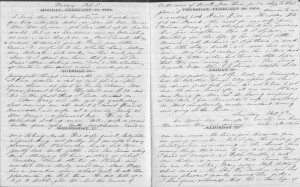 I just received my order of two copies of a lovely 2019 calendar from Wales (one for me and one for my brother). It is illustrated with paintings of village life in Wales by Welsh artist Valeriane LeBlond (www.valeriane-leblond.eu). The calendar text is in Welsh, so I can’t translate the titles, but the scenes include little white cottages with quilts hung out to air (even in the snow), row houses exactly like those I know my ancestors lived in, bucolic landscapes – this is the southern part of Wales, great farming country – with wind-whipped waves off shore. Neat stuff. Continue reading Pictures from “home”
I just received my order of two copies of a lovely 2019 calendar from Wales (one for me and one for my brother). It is illustrated with paintings of village life in Wales by Welsh artist Valeriane LeBlond (www.valeriane-leblond.eu). The calendar text is in Welsh, so I can’t translate the titles, but the scenes include little white cottages with quilts hung out to air (even in the snow), row houses exactly like those I know my ancestors lived in, bucolic landscapes – this is the southern part of Wales, great farming country – with wind-whipped waves off shore. Neat stuff. Continue reading Pictures from “home”
Monthly Archives: September 2018
Cousins of St. Casimir
Above, left: Eugénie Vallée. Above, right: Marie Trottier.
This blog post, a sequel to “The widow of St. Casimir,” contrasts the lives of two women, Eugénie Vallée (1880–1973) and Marie Trottier (1855–1928), first cousins born in St. Casimir, Québec a generation apart. (Eugénie’s mother, Lumina de Varennes [1844–1922], was the younger sister of Marie’s mother, Léocadie de Varennes [1828–1897].) Marie came to my attention through an online family tree with an elegant photo of her circa 1875. Eugénie’s grandchildren were immediately struck by the strong resemblance between their grandmother at the same age and Marie. Did these look-alike cousins, who likely never met, have similar experiences in their migration path to the Unites States, where they lived the majority of their lives? Continue reading Cousins of St. Casimir
ICYMI: Boston riches
[Author’s note: This blog post originally appeared in Vita Brevis on 23 February 2017.]

As I complete publishing excerpts from the 1865 volume, the final year in what I hope will be a single-volume account of the Civil War in the Hedwiga Regina Shober Gray diary, it seems like a good time to revisit a Gray diary primer from 2017.
Certain diaries, and their authors, become short-hand for a time and place: Samuel Pepys’s diary of seventeenth-century London, for example, or Anne Frank’s diary of wartime Amsterdam. The diaries of Philip Hone and George Templeton Strong are often invoked to cover the first half of the nineteenth century in New York; for the Civil War years, readers turn to Mary Boykin (Miller) Chesnut’s Diary from Dixie (1905). Continue reading ICYMI: Boston riches
‘Aching hearts’

61 Bowdoin Street, Boston, Tuesday, 12 December 1865: On Wednesday, Nov. 30, 1864, we laid our dear brother John[3] in the quiet church yard at St. James the less.[4] He died on Sunday the 27th. Just one year from that sad day, the darling of all our hearts, my sister Lizzie, lay at the last gasp apparently – and though she rallied for a few days of inexpressible comfort to us all, she too left us on Friday Dec 1st and was laid by his side, on just such a soft Indian summer [day] as we had for him, on Monday, Dec. 4th, 1865. She was so wasted and altered that I can not realize yet, that it was our bright cheery Lizzie we left there.
It was Suffering & Death we laid in the cold dark tomb, not our darling; even the profile was unnatural, all the sweet smiling lines, drawn & rigid – and the plain hair, parted back like a child’s, and cut short, for its length & weight distressed her so, looked so unlike the rich full puffs, every wave of which caught such a rich golden auburn glow, upon its lovely chestnut brown. Continue reading ‘Aching hearts’
Essayons
 At last, the cast of Volume 2 of Early Families of New England 1641-1700 is set. See below for a list of all fifty sketches.
At last, the cast of Volume 2 of Early Families of New England 1641-1700 is set. See below for a list of all fifty sketches.
The inventory includes five sets of siblings: John and Samuel Carter; Andrew and George Lane; Daniel, John, and Joseph Morse; Joshua and Thomas Scottow (and brother-in-law Robert Winsor); and John and Samuel Sherman.
Three women have sketches in this volume: Mary (Smith) (Glover) Hinckley, Jane (Conant) (Holgrave) Mason, and Amyas (Cole) (Thompson) Maverick, in addition to their husbands: Thomas Hinckley, Nathaniel Glover, Joshua Holgrave, and Samuel Maverick. Continue reading Essayons
Snail mail
 As I have mentioned in other blog posts, the focus of my research has been on my maternal ancestry from Ireland, Germany, and Italy. While researching my Italian heritage, I have come across various places listed as my ancestors’ places of birth, from tiny frazioni (the equivalent of a parish) to various larger comuni (towns). To make researching my Italian ancestry harder is the fact that I am from the northern part of Italy, about 40 miles outside of Milan. Continue reading Snail mail
As I have mentioned in other blog posts, the focus of my research has been on my maternal ancestry from Ireland, Germany, and Italy. While researching my Italian heritage, I have come across various places listed as my ancestors’ places of birth, from tiny frazioni (the equivalent of a parish) to various larger comuni (towns). To make researching my Italian ancestry harder is the fact that I am from the northern part of Italy, about 40 miles outside of Milan. Continue reading Snail mail
Don’t fence me in
 I grew up on this long-time family-owned property next door to my paternal grandparents, Rex Church (1883–1956) and Winifred Lee (1884–1980). I saw them almost every day until their deaths, ate lunches and holiday meals with them, slept overnight there with my cousins, and saw them only as my grandparents. I suspect that, like many other people, I’ve only come to really know them as I piece together family stories.
I grew up on this long-time family-owned property next door to my paternal grandparents, Rex Church (1883–1956) and Winifred Lee (1884–1980). I saw them almost every day until their deaths, ate lunches and holiday meals with them, slept overnight there with my cousins, and saw them only as my grandparents. I suspect that, like many other people, I’ve only come to really know them as I piece together family stories.
Long after my grandparents’ deaths, my brother and I took on the task of clearing out the house in preparation for his renovations. I began to learn more about my grandparents the more old photos we found between pages of every book or magazine (I’m not sure who was reading the collected speeches of Andrew Jackson, but there it was), and taking down framed photos, mostly of grandchildren and great-grandchildren. Continue reading Don’t fence me in
Further ancestors of the Princess of Wales
 Finishing up the generation of the Princess of Wales’s great-great-great-great-grandparents – as part of a review of scholarship that has become available since Richard Evans’s book, The Ancestry of Diana, Princess of Wales, was published in 2007 – there is something more to be said about her matrilineal ancestress in that generation, Eliza Kewark (or Kevorkian) of Surat in the Indian state of Gujurat.[1]
Finishing up the generation of the Princess of Wales’s great-great-great-great-grandparents – as part of a review of scholarship that has become available since Richard Evans’s book, The Ancestry of Diana, Princess of Wales, was published in 2007 – there is something more to be said about her matrilineal ancestress in that generation, Eliza Kewark (or Kevorkian) of Surat in the Indian state of Gujurat.[1]
The daughter of Jakob Kevork/Hakob Kevorkian, and sister-in-law of Aratoon Baldassier (or Baldassarian), her voice may be heard in a series of letters she wrote to her partner (and, perhaps, husband) Theodore Forbes between 1812 and 1819; the last – concerning Forbes’s plan to send their daughter to his family in Scotland – strikes a formal note: Continue reading Further ancestors of the Princess of Wales
How long is a generation?
![]() Much of my attention over the last eighteen months has been focused on creating the online database Mayflower Families Fifth Generation Descendants, 1700-1880. It was great to make this resource available to help people research their Mayflower ancestry.
Much of my attention over the last eighteen months has been focused on creating the online database Mayflower Families Fifth Generation Descendants, 1700-1880. It was great to make this resource available to help people research their Mayflower ancestry.
Now we have a database with nearly 165,000 birth, marriage, and death records, and thus a unique opportunity to do some analysis on the Mayflower fifth generation descendants in aggregate, looking for interesting facts about this group. Continue reading How long is a generation?
Who are the Rogerenes?

While attending the FGS conference in Fort Wayne, Indiana, in August, Lynn Martin of Paw Paw, Michigan visited the NEHGS booth in the vendor hall and introduced me to her early immigrants – specifically her Rogers family. John Rogers, Sr. founded his own religion – the Rogerenes, in 1674 – in New London, Connecticut. Today, the only tangible remains of this religion in Connecticut are the neighborhoods of Quaker Hill in Waterford and Quakertown in Ledyard. While sometimes referred to as the Rogerene Quakers, they actually never had any association with the Society of Friends. Instead, their roots come from the Seventh Day Adventists. Continue reading Who are the Rogerenes?

